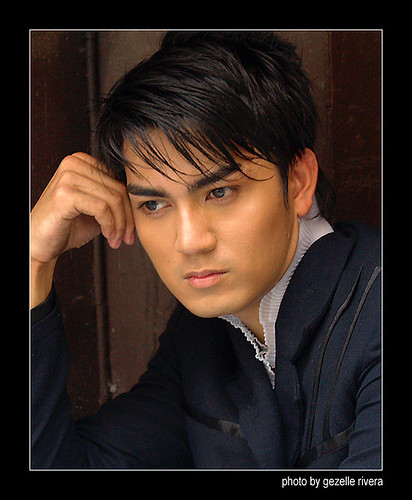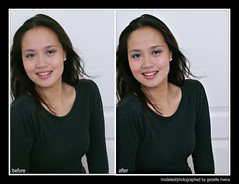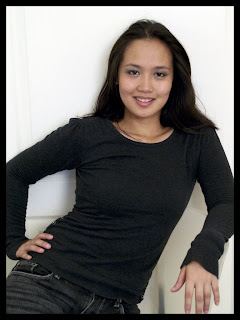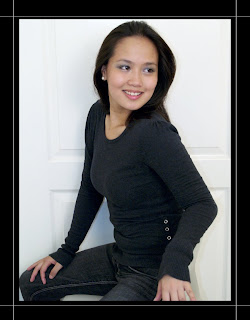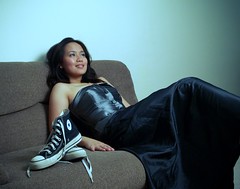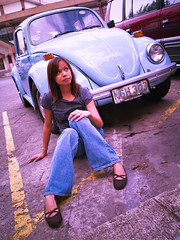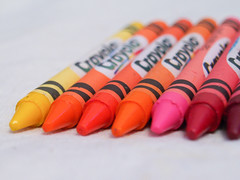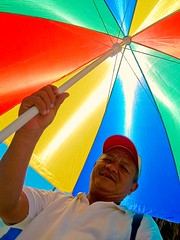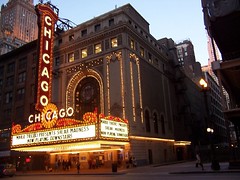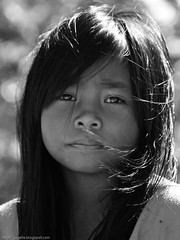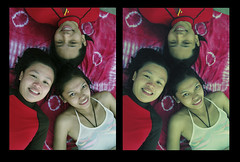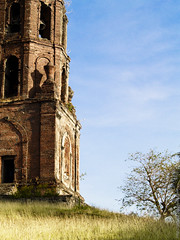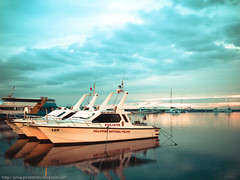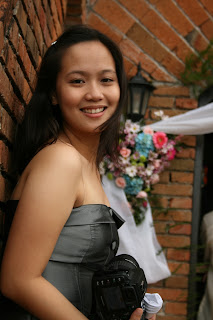Saturday, July 12, 2008
the one with gino and marjo
anyway, sana matuwa rin kayo sa mga output, folks. there's more in my multiply site. feel free to check them out. thanks and God bless!
Portfolio: Gino Cabrillas
Model: Gino Cabrillas
Model Stats: height 5'11" / weight 162lbs / chest 36" / waist 31" / shoes 11" / hair black / eyes black
Make-Up: Julius Uy
Clothes: Boying Eustaquio of Phil. Academy of Fashion Designers (PAFD)
Photography: Gezelle Rivera
Venue: UP DIliman
Date: July 5, 2008
More photos at: http://littlealtars.multiply.com/photos/album/104
Saturday, May 3, 2008
The Sharpening Project
I have read about manny librodo's post-processing style a few months ago, but never got the chance to try it until this morning. even just after applying the first two steps from his sharpening method, i was already very happy with the results and truly liked what i was seeing. To appreciate the difference, you will need to view the image in full size.
Here are the detailed steps taken in order to achieve the sharp image on the right:
1. Background copy
2. USM 18-40-0
3. USM 150-.3-0
4. Edit>Fade USM 100% in Darken Mode
5. USM 150-.3-0
6. Edit>Fade USM 50% in Lighten Mode
7. Flatten image
Since what i own is an entry-level dslr, i have learned to accept that my photos will never be as sharp as those produced by other dslrs, especially canon. Even when i would shoot at my lens' sweet spot, i would often observe that some sharpness (or "crispness") in the photos was lacking. Apparently, this was a common problem with most digital images. But luckily for us, Adobe Photoshop deals with this dilemma quite effectively by providing us with the USM Tool (Unsharp Masking Tool), accessible under the "Filter > Render" Menu.
I could not fully comrepehend what goes on technically during the Unsharp Masking process, but I really love the results. You have to try this to believe, and do not hesitate any bit! The entire "USTe" set which was taken using a Canon IXUS point-and-shoot was post-processed to apply this sharpening technique.
To understand more about the USM Tool, you may read this article from photocritic.
Many thanks to Sir Manny for sharing his technique to the world!
If this article was helpful to you, please let me know. God bless and happy shooting!
Friday, May 2, 2008
Layout Study #1
Because I could not install Adobe InDesign with my current OS, I decided to go ahead and create a photo layout using Adobe Photoshop CS3 anyhow, even though I was aware that InDesign or Elements can do the job much easier and a lot faster. This is something I had wanted to do for a long time now and I did not want to delay any longer.
For my first photo layout study, I chose images from this Multiply set which is a recent addition to a self-portrait series I'm doing. I really thought it would be difficult to use CS3 for this task, but it turned out to be a little less challenging than I thought. I guess I'm a little lucky today!
Here are some technical specifics which I'm writing here so that I can remember what it's like to do this someday :) Please feel free to make suggestions and/or provide comments. I'm still a beginner and I welcome any help I can get. I'm hoping that you'll learn a thing or two as well.
To come up with this layout, the following layers had to be used:
1. layer for the large photo on the left
2. layer for the black vertical bar on the right
3. layer for the top photo
4. layer for the center photo (next layer from the top)
5. layer for the bottom photo (topmost layer)
The smaller photos were added using the "File > Place" command and were resized, rotated using the inherent transform control bar. before placing the three smaller photos in this layout, they were individually edited and added with an outline border (see previous post on this) first.
When the layout was complete, the layers were merged by the "Layer > Flatten Image" command. Curves were adjusted as a whole and the photo was sharpened using the "Filter > Sharpen" tool before I exported using the "Save for Web" option. All image adjustments were made in sRGB, 16Bits/Channel mode.
Do let me know if this post was helpful in any way and whether you liked this photo layout or not.
Thanks and God bless!
about borders
Monday, April 28, 2008
my chucks and i
the first good photos came out after 90 minutes of testing and figuring out what to do. i wanted to stand up but my head gets cut-off because there wasn't enough room in my house for stepping backwards and i wasnt comfortable in shooting at portrait mode.
the next challenge was posing to make sure i looked good and my flaws were not too evident. it doesnt help that the gown was tight in the tummy area which made bending or slouching impossible because every time i would, a bulk (or two) around my stomach would show up. definitely not a pretty sight.
as before, the setup was pretty basic. there was one light source that was constant and diffused by a white umbrella. in manual mode, my setting was similar to what i had used in my other DIY sets with the
lens almost at 35mm and aperture at f5.6. shutter was at 1/40 and white balance was in bulb setting.
please let me know what you think of the odd pair set. thanks and have a good day!
Wednesday, April 23, 2008
the one with the volkswagen
this photo was shot at the parking lot of the SLU campus in baguio. the car isnt ours and in fact, we dont own one. we just saw this beetle on our way out of the university after having attended her brother's hooding ceremony. the ceremony was amazing and was part of the graduation rites, in case you were wondering.
it was not difficult for me to come up with the body pose. i knew i wanted to shoot her sitting at the front. i knew i wanted one leg stretched and the other bent. but i kept on struggling about the facial expression. i didnt know how i wanted it to be. in the end, she helped me out and made several faces. she smiled, she frowned, she looked up, she looked down, she appeared serious, she appeared lost... but in the end, i chose this: her "my car got broken and i have been waiting for a while now so please help me fix it or something like that" look :)
as usual, this was shot using my olympus evolt e-500, my kit lens set at 35mm and aperture of f5.6. iso is probably 100 or 200. the photo was mildly post-processed using lightroom to provide a purplish tone to the highlights and to crop the photo a little bit.
c&c's are welcome! thanks and God bless! :)
Monday, April 14, 2008
crayons
photo taken at home this morning. the crayons were spread out in a white cloth and the lighting source was an incandescent bulb, situated almost near the ceiling. white balance was adjusted to match lighting source.
other info: iso 320, f5.6, shutter was 1/20. shot using my kit lens.
Tuesday, April 8, 2008
Photography Composition Tips
Taken from "101 Photography Tips" by Chris Marquardt
http://www.tipsfromthetopfloor.com/
- Focus then recompose. Many cameras allow you to pre-focus a shot by half-pressing the shutter button, and then when the right moment is there, fully press the shutter. This way you can capture that perfect moment more precisely, especially with older point-and-shoot cameras that have a longer shutter delay than more recent ones.
- Learn to love overcast days. The dynamic difference between shadows and harsh sunlight at noon is hard to handle for most digital cameras. The diffuse light conditions on an overcast day are your friend.
- Get closer. Robert Capa said: "If your pictures aren't good enough, then you aren't close enough". Next time you take a picture, try to walk a few steps towards the subject, or even pick out a detail of a scene rather than the whole thing in one. You'll be surprised.
- One subject only. Pictures often work better if there's a clear subject. Competing subjects are hard to handle.
- Don't forget about the background. Often you find yourself paying a lot of attention to the subject (the foreground) and completely ignoring the background. The background is as important as the foreground, it is a part of your image. A simple step to the left or right will help you avoid things like branches of trees growing out of your subject's head.
- Change your point of view. Every day we see the world from our own perspective, usually from our own eye level. Change your perspective by shooting from a frog's perspective or from within a fridge and create an unusual look that people won't forget.
- Moving subjects need space. Your compositions of a car, a bicycle or someone walking will usually look nicer if you give the subject some space in your image to move into.
- Use negative space. Negative space is the part of an image that is not your subject. Don't be afraid to use lots of it every now and then.
- Avoid falling lines. Tilting the camera up when taking pictures of buildings will produce "falling lines", e.g. the building will look as if its leaning backwards. Sometimes that cannot be avoided. This can usually be fixed in post processing.
- Keep water lines horizontal. If you take an image of a lake or the sea, make sure to keep the horizon level. Even a slight skew of half a degree will make the viewer feel uncomfortable with the picture.
Wednesday, April 2, 2008
colors of summer
photo was taken at aperture priority mode -- iso100, f4, 1/2500. some areas were totally washed out and could no longer be recovered because aperture was too wide open. i should have adjusted that to at least f11 and took some more care metering the scene. oh well... when i see another manong selling colorful summer umbrellas on the beach once again, id know better what to do :)
enjoy your summer everyone!
portrait of a bride
this photo was shot in aperture mode at iso125 and f4.5. i used spot metering in order to meter her face and body correctly and make the curtain appear slightly washed out. comments and criticisms are welcome :)
i was the last bridesmaid to be made-up and prettied-up by the beautician and ended up not being able to walk down the aisle -- the girl before me took too long to get her hair fixed! i should have just skipped the make-up part altogether and combed my own hair or powdered my own face. or better yet, i should have convinced my friend to hire me to become her backup photographer instead, hehehe!
Monday, March 31, 2008
chicago theater photo at travelmuse
this photo was chosen to be the header for a feature on Chicago within travelmuse, a travel website offering potential travelers fun facts about the destination, historical background, ways to explore the featured destination, how to get there and around, where to dine and drink and where to stay.
i have always liked this photo and made it my cover for my chicago set in flickr. although it was taken using just my point and shoot, a kodak, i thought that the colors and exposure was rendered beautifully and dramatically.
the travelmuse site cropped the photo however to turn this into a banner so that the portions that were rendered out of focus in the photo was dominant and enlarged in the banner. not a good way to use this photo but i cant complain. im still very glad my travel photo chosen!
to visit travelmuse's feature on chicago, you may click here.
sad eyes
hers is one of the saddest faces i have ever taken a photo of. i guess she wouldnt smile because she was feeling uncomfortable with all the strangers pointing their cameras at her and shooting away, myself included. she was probably wondering what we saw special in her after all, she was just playing child games that morning like she always does by the shore... she had no idea how beautiful she is and how lovely the setting was!
when most of the photographers had lost interest in her, i stayed on and tried to show her pictures which i have taken of her. i wanted her to see what we saw in her. at that point, she started to smile and showed how much more beautiful and unforgettable she really was.
Friday, March 28, 2008
anino
anino in english means shadow. photo was originally taken in one of the empty rooms within an old lighthouse in ilocos. it was an hour or two before sunset so the shadows were really interesting.
original photo was taken in black and white so there was little post-processing that had to be done. camera used was an olympus evolt e500 set at iso 200, f3.5 and 1/400.
you may view the entire set here. please let me know what you think!
Top 10 Digital Camera Tips
You've heard this before: Digital cameras do all the work. You just push the button and great pictures magically appear. The better the camera, the better the photos. Isn't that right? Heck no!
The truth is that you can make great photos with a simple consumer point-and-shoot camera, or take lousy shots with the most expensive Nikon. It's not the camera that makes beautiful images; it's the photographer. With a little knowledge and a willingness to make an adjustment here and there, you can squeeze big time photos out of the smallest digicam.
To help you down the road to great image making, here are ten tips that will enable you shoot like a pro (without maxing out your credit card on all that expensive equipment).
1. Warm Up Those Tones
Have you ever noticed that your shots sometimes have a cool, clammy feel to them? If so, you're not alone. The default white balance setting for digital cameras is auto, which is fine for most snapshots, but tends to be a bit on the "cool" side.
When shooting outdoor portraits and sunny landscapes, try changing your white balance setting from auto to cloudy. That's right, cloudy. Why? This adjustment is like putting a mild warming filter on your camera. It increases the reds and yellows resulting in richer, warmer pictures.
If you don't believe me, then do a test. Take a few outdoor shots with the white balance on auto, then take the same picture again with the setting on cloudy. Upload the images to your computer and look at them side by side. My guess is that you'll like the warmer image better.
2: Sunglasses Polarizer
If you really want to add some punch to your images, then get your hands on a polarizing filter. A polarizer is the one filter every photographer should have handy for landscapes and general outdoor shooting. By reducing glare and unwanted reflections, polarized shots have richer, more saturated colors, especially in the sky.
What's that you say? Your digital camera can't accommodate filters. Don't despair. I've been using this trick for years with my point-and-shoot cameras. If you have a pair of quality sunglasses, then simply take them off and use them as your polarizing filter. Place the glasses as close to the camera lens as possible, then check their position in the LCD viewfinder to make sure you don't have the rims in the shot.
For the best effect, position yourself so the sun is over either your right or left shoulder. The polarizing effect is strongest when the light source is at a 90-degree angle from the subject.
3. Outdoor Portraits That Shine
One of the great hidden features on digital cameras is the fill flash or flash on mode. By taking control of the flash so it goes on when you want it to, not when the camera deems it appropriate, you've just taken an important step toward capturing great outdoor portraits.
In flash on mode, the camera exposes for the background first, then adds just enough flash to illuminate your portrait subject. The result is a professional looking picture where everything in the composition looks good. Wedding photographers have been using this technique for years.
After you get the hang of using the flash outdoors, try a couple variations on this theme by positioning the subject so the sun illuminates the hair from the side or the back, often referred to as rim lighting. Another good technique is to put the model in the shade under a tree, then use the flash to illuminate the subject. This keeps the model comfortable and cool with no squinty eyes from the harsh sun, and this often results in a more relaxed looking portrait.
Remember, though, that most built-in camera flashes only have a range of 10 feet (or even less!), so make sure you don't stand too far away when using fill flash outdoors.
4. Macro Mode Madness
Remember as a kid discovering the whole new world beneath your feet while playing on the grass? When you got very close to the ground, you could see an entire community of creatures that you never knew existed.
These days, you might not want to lie on your belly in the backyard, but if you activate the close up mode on your digital camera and begin to explore your world in finer detail, you'll be rewarded with fresh new images unlike anything you've ever shot before.
Even the simplest object takes on new fascination in macro mode. And the best part is that it's so easy to do with digital cameras.
Just look for the close up or macro mode icon, which is usually a flower symbol, turn it on, and get as close to an object as your camera will allow. Once you've found something to your liking, hold the shutter button down halfway to allow the camera to focus. When the confirmation light gives you the go ahead, press the shutter down the rest of the way to record the image.
Keep in mind that you have very shallow depth of field when using the close up mode, so focus on the part of the subject that's most important to you, and let the rest of the image go soft.
5. Horizon Line Mayhem
For some mysterious reason, most human beings have a hard time holding the camera level when using the LCD monitors on their digicams. The result can be cockeyed sunsets, lopsided landscapes, and tilted towers.
Part of the problem is that your camera's optics introduce distortion when rendering broad panoramas on tiny, two-inch screens. Those trees may be standing straight when you look at them with the naked eye, but they seem to be bowing inward on your camera's monitor. No wonder photographers become disoriented when lining up their shots.
What can you do? Well, there's no silver bullet to solve all of your horizon line problems, but you can make improvements by keeping a few things in mind.
First of all, be aware that it's important to capture your images as level as possible. If you're having difficulty framing the scene to your liking, then take your best shot at a straight picture, reposition the camera slightly, take another picture, and then maybe one more with another adjustment. Chances are very good that one of the images will "feel right" when you review them on the computer. Simply discard the others once you find the perfectly aligned image.
If you practice level framing of your shots, over time the process will become more natural, and your percentage of level horizon lines will increase dramatically.
6: Massive Media Card
When you're figuring out the budget for your next digital camera, make sure you factor in the purchase of an additional memory card. Why? Because the cards included with your new high-tech wonder toy are about as satisfying as an airline bag of peanuts when you're dying of hunger.
If you have a 3 megapixel camera, get at least a 256MB card, 512MBs for 4 megapixel models, and 1GB for for 6 megapixels and up.
That way you'll never miss another shot because your memory card is full.
7: High Rez All the Way
One of the most important reasons for packing a massive memory card is to enable you to shoot at your camera's highest resolution. If you paid a premium price for a 6 megapixel digicam, then get your money's worth and shoot at 6 megapixels. And while you're at it, shoot at your camera's highest quality compression setting too.
Why not squeeze more images on your memory card by shooting a lower resolution and low quality compression settings? Because you never know when you're going to capture the next great image of the 21st century. And if you take a beautiful picture at the low 640 x 480 resolution, that means you can only make a print about the size of a credit card, not exactly the right dimensions for hanging in the museum.
On the other hand, if you recorded the image at 2272 x 1704 (4 megapixels) or larger, then you can make a lovely 8- x 10-inch photo-quality print suitable for framing or even for gracing the cover of Time magazine. And just in case you were able to get as close to the action as you had liked, having those extra pixels enables you to crop your image and still have enough resolution to make a decent sized print.
The point is, if you have enough memory (and you know you should), then there's no reason to shoot at lower resolution and risk missing the opportunity to show off your work in a big way.
8: Tolerable Tripod
I once overheard someone say, "He must be a real photographer because he's using a tripod." Well, whether or not you use a tripod has nothing to do with you being a true photographer. For certain types of shots though, these three-legged supports can be very useful.
The problem is tripods are a pain in the butt to carry around. They are bulky, unwieldily, and sometimes downright frustrating. Does the phrase "necessary evil" come to mind?
For digital shooters there's good news: the UltraPod II by Pedco. This compact, versatile, ingenious device fits in your back pocket and enables you to steady your camera in a variety of situations. You can open the legs and set it on any reasonable flat surface such as a tabletop or a boulder in the middle of nowhere. But you can also employ its Velcro strap and attach your camera to an available pole or tree limb.
You might not need a tripod that often, but when you do, nothing else will work. Save yourself the pain and money of a big heavy lug of a pod, and check out the svelte UltraPod. Yes, then you too can be a real photographer.
9: Self Timer Fun
Now that you have your UltraPod in hand, you can explore another under-used feature found on almost every digital camera: the self timer. This function delays the firing of the shutter (after the button has been pushed) for up to 10 seconds, fixing one of the age old problems in photography: the missing photographer.
Hey, just because you've been donned as the creative historian in your clan, that doesn't mean that your shining face should be absent from every frame of the family's pictorial accounting. You could hand your trusty digicam over to strangers while you jump in the shot, but then you take the chance of them dropping, or even worse, running off with your camera.
Instead, attach your UltraPod, line up the shot, activate the self timer, and get in the picture. This is usually a good time to turn on the flash to ensure even exposure of everyone in the composition (but remember that 10 foot flash range limit!). Also, make sure the focusing sensor is aimed at a person in the group and not the distant background, or you'll get very sharp trees and fuzzy family members.
Self timers are good for other situations, too. Are you interested in making long exposures of cars driving over the Golden Gate Bridge at dusk? Once again, secure your camera on a tripod, then trip the shutter using the self timer. By doing so, you prevent accidental jarring of the camera as you initiate the exposure.
10. Slow Motion Water
I come from a family where it's darn hard to impress them with my artsy pictures. One of the few exceptions happened recently when my sister commented that a series of water shots I had shown her looked like paintings. That was close enough to a compliment for me.
What she was responding to was one of my favorite types of photographs: slow motion water. These images are created by finding a nice composition with running water, then forcing the camera's shutter to stay open for a second or two, creating a soft, flowing effect of the water while all the other elements in the scene stay nice and sharp.
You'll need a tripod to steady the camera during the long exposure, and you probably should use the self timer to trip the shutter. If you camera has an aperture priority setting, use it and set the aperture to f-8, f-11, or f-16 if possible. This will give you greater depth of field and cause the shutter to slow down.
Ideally, you'll want an exposure of one second or longer to create the flowing effect of the water. That means you probably will want to look for streams and waterfalls that are in the shade instead of the bright sunlight.
Another trick is to use your sunglasses over the lens to darken the scene and create even a longer exposure. Plus you get the added bonus of eliminating distracting reflections from your composition.
Saturday, March 22, 2008
Surfer Girls
photo was taken in the afternoon of the surfing trip. they were my roommates. that is my sarong and that "strawberry fields forever" song was playing in my head all day long. (my sentences tend to rhyme when im sleepy).
photo on the left was minimally enhanced. picture was rotated 90 degrees CW and PS was used to adjust levels and remove facial imperfections using the healing brush.
photo on the right was applied with digital "cross-processing" techniques to give it a 70s look and feel. the goal was to add brown and greenish tones to the photo and desaturate the colors. the tutorial came from photoshopsupport.com
not sure if you'd like the "70s version" better than the original, but i really had fun following the "recipe" and looking forward to doing more of this. my friend was telling me im becoming a "photoshoper" more than becoming a photographer. i dont mind. who knows, maybe i can be both :)
let me know what you think! thanks and God bless this easter!
Monday, March 17, 2008
Olympus 35mm f3.5 Zuiko Digital Macro

Zuiko Digital 35mm, f3.5 lens
Ultra lightweight macro lens of 165g. The focal length is equivalent to 70mm on a 35mm camera and it has a very good cost performance. You do not need any extensions to get 1:1 (life-size) magnification (equivalent to 2x on a 35mm camera). You can bring this compact lens everywhere, and enjoy taking close-up pictures in your daily scenes, such as, flowers and insects. It is also useful as a standard lens for landscape, snap shots and portrait photography.
Specifications
Focal Length: 35mm (35mm equivalent focal length 70mm)
Lens construction: 6 Elements in 6 Groups
Angle of View: 34 Degree
Closest Focusing Distance: 0.146m
Maximum Image Magnification: 1.0x (35mm equivalent Maximum Image Magnification 2.0x)Minimum Field Size: 17 x 13 mm
Number of Blades: 7 (Circular aperture diaphragm)
Maximum Aperture: f 3.5
Minimum Aperture: f 22
Filter Size: 52 mm
Dimension: Diameter 71 x 53mm
Weight: 165g
Tele Converter EC-14: Yes
Extension Tube EX-25: Yes
Lens Cap: LC-52B (52mm)
Sunday, March 16, 2008
at the windmills
from my photoshop cs2 version, i played around with the "photo filter" utility and eventually chose "deep yellow filter" for this photo. i wanted to saturate the colors in her clothing so that she would stand out from the background dramatically. this is something hard to achieve with lightroom. photoshop really rocks :)
Wednesday, March 12, 2008
riding waves in la union
camera was on shutter priority. speed was at 1/250 so i can freeze the movement. iso was at 100 since it wasnt dark yet. photo was edited in lightroom by applying the direct positive preset and changing the highlights to aqua.
Monday, March 3, 2008
Happy Days

Hello friends!
We are a happy bunch of photographers who started out with photography as a hobby last 2005 (much, much earlier for my brother Dan). As time went on, our friends started noticing our passion for this craft and would begin to "commission" us to become their photographers for their own weddings and birthdays and other family gatherings and small enterprise happenings. We thought that was really something we enjoyed doing... so eventually we came up with an idea to offer our freelance services individually, and then later on (together with an Accenture colleague), as a group. I guess this story is typical for most photographers. We are probably not that different except that we are also a happy and passionate people and we like telling stories through our photos.
With this, I invite you all to visit our online gallery at http://happydaysfoto.multiply.com/
If you have a Multiply account, feel free to add us as your contact as well. Thank you very much and I hope you have a happy day!
Thursday, February 28, 2008
Wednesday, February 27, 2008
Bantay Bell Tower in Vigan
Tuesday, February 26, 2008
yuka takes a bath
photo taken at iso400, f3.5, 1/80 of a second. i was using my semi-telephoto for this. hues were modified using lightroom.
Sunday, February 17, 2008
red sunset
Saturday, February 16, 2008
at the harbor square
so i thought my photos look boring and flat compared to those ive seen from a lomo set in flickr. ugh. really envious of the color and the vibrance and the freedom in taking those photos! so i decided to pick one from the manila bay set and "lomify" it on my own way. this was over-exposed using lightroom and the tint for the highlights/shadows were also replaced. i was trying to mimic the "green" lomo cam effect. whether i had achieved that or not... im really not sure. but what im sure of is that i had fun doing this and i plan to do more "lomofication" in the coming weeks.
sepia sky
manila bay at night
 ...deep blue manila sky...
...deep blue manila sky...camera: olympus evolt e-5oo, lens was 17.5 to 45mm (kit lens)
Wednesday, February 13, 2008
of turtles and tripods

by the way, thank you Guids for teaching me and telling me how "talas" my lenses can be at f8 and also for introducing me to the wonderful world of tripods. thank you rin to my pastor Amel who will lend me his tripod for my ilocos tour next weekend. hooray!
Monday, February 11, 2008
photography is an art of observation
“To me, photography is an art of observation. It's about finding something interesting in an ordinary place... I've found it has little to do with the things you see and everything to do with the way you see them.” -Elliot Erwitt
Friday, January 25, 2008
some photoholic thoughts
- camera sensor cleaning -- there's such a thing. you need to know how it's done. or find someone who can do it for you. marunong daw si marty sabi ni skip :)
- fungus can develop on the lenses. i already know this, but nearly not doing anything to prevent it. tsk tsk. i did more research and here's what i found:
Keep your lenses in a dry, cool place. If you use your equipment in damp environments, let it dry as soon as you return into a drier room. Never leave your equipment in a closed (splashproof) camera bag when it need not be there. Leather lens cases are known to be especially bad, because leather is a natural product where fungi can grow before they proceed on to the lens. Synthetic materials are better, but there is no guarantee there either.
If you store the equipment in a sealed (air-tight) case, adding a small bag of silica gel or other absorbent may help. You will need to monitor the status (usually a change in color of an additive) regularly. As soon as the gel shows signs of saturation with water, it should be replaced or dried. Otherwise the process will reverse, and instead of drying the case, it will add moisture to the air and make things worse.
Source: http://www.chem.helsinki.fi/~toomas/photo/fungus/
- i really need to buy those silica gels now because my bag of gel (which i know to be expired by now) could already be reversing the process. yikes. time to visit the handyman.
- how to tell if the "dirt" is on the sensor or on the lens itself. you use a different lens or change focal length then shoot several photos. observe. if the position of the "dirt" does not change with differing focal length, "dirt" is sitting on the sensor. if position changes with differing focal length, then "dirt" is on the lens.
- if there is dirt on the lens, have the lens cleaned by the service center. cost could be around P500 per lens.
- we need to keep humidity from 40 to 60 within our storage boxes to prevent fungi from infecting the lenses. for this i need a hygrometer. cost of a digital hygrometer is P800. Analog is P400. The box can be an air-tight Lock & Lock container. You can buy all these at SM. Digital is better.
- the new canon 450D is out. it has live view (yehey!) and costs $900. i think i will also save up for this.
- how to setup lights using the following: light stand (around P700), umbrella holder (around P800), umbrella (P700), and external flash. very easy. point the flash towards the umbrella and let the light bounce. the umbrella is lined with a silver material which reflects light better than white surfaces do. need to save money for these equipment.
- shooting portraiture with external flash is better than built-in flash. definitely already know this from the time i bought my vivitar flash, but i didn't know how hard having an external flash would be compared to placing that flash in a light-stand and a reflector-umbrella! life is just so much easier when the flash is on the stand and light is being reflected by the umbrella as opposed to having the flash attached to the camera and bouncing light off the walls or the ceiling. with flash attached to the camera, you start having problems the moment you switch from landscape to portrait or vice versa! you will have to re-adjust the flash each time... and the camera gets heavy and blur may most likely occur! im sure it takes getting used to, but at the start, its so cumbersome. moving forward, use light-stands for portraitures.
- do not trust your eyes and the LCD in gauging whether exposure is good. LCDs can be deceiving. inspect histogram and/or buy light meter. or assume that you need to "over-expose" a little if you know that your LCD tends to brighten things up for you. experiment.
that's it for now... i feel that there's a few more.... when i remember them, ill definitely share them. in the mean time, happy weekend and happy shooting!
please visit my photoblog at http://pinayphotoholic.blogspot.com
Wednesday, January 23, 2008
sa hardin ni sonya
ever been to sonya's garden in tagaytay? if ever you're thinking of going away from all the chaos and pollution of the city, consider a 2-hour drive to tagaytay and spend an unforgettable lunch over at sonya's garden. i was fortunate enough to try their menu last weekend consisting of fresh salad, pasta (w/ several kinds of sauce, salmon belly, and ratatouille), dalandan juice, taragon tea and chocolate cake. price is a little bit steep but at least what you're getting is all fresh, good and healthy. they even served freshly baked bread which i enjoyed truly with all their delicious dips. favorite ko syempre yung pesto :) i have more photos from my multiply site. to visit that, you may click here. enjoy the photos!

....gulong ng silya sa may hardin...

...eto naman ang panghimagas...
Tuesday, January 22, 2008
me and my photoholic self
trying to be a model for sherwin, also from our photography club
trying to take pictures during the wedding --
it turned out to be very challenging given the dress and shoes i was wearing!
Thursday, January 17, 2008
the one from the pink bathroom at home
these photos have been taken from the pink bathroom at my parents' home. there's a large pail of water in the bathroom and water from the faucet has been dripping slowly but constantly. i was taking photos of the tiles and things you can find inside the medicine cabinet then thought of taking a picture of the "tabo" inside this large pail when i saw that it had bubbles in it. i was interested in the bubbles at first but soon enough i realized i could take a picture of the ripples and the water drops as well. they turned out to be the more interesting subject eventually.

photos have been taken with 1/64th flash and then edited with adobe lightroom to change their tint, because pink didn't seem quite dramatic to me. sizes are large enough for you to set these as desktop wallpaper. just right-click on the photos and select "set as desktop background". for more "splash" photos, please visit this multiply album.
i learned so much from tonight. glad i took my camera out before going to bed at 1am in the morning :)
Tuesday, January 15, 2008
the one where i got sort of published

when i would take pictures of people, i would whisper "litrato, por favor", give them a friendly im-not-a-psycho smile and lift my camera a little bit with my right hand. of course nobody hears me speaking, but the people knew what i meant. these phrases were what i used to say to people when i went traveling to colombia last 2005. i thought it's okay to use because no one would hear anyway and really, the equivalent in english doesn't sound quite the same.
at some point, i decided to walk over the breakwater. from where i was standing, i could see the the tall buildings in chicago (one of which is the famous and very memorable John Hancock building) with the beach and the people on the shore as the foreground. there were strong waves that day and that meant strong winds which made me very uncomfortable. i took one shot, and fearing that i might slip or be thrown over the water, headed quickly back to the shore.
that's it. one shot, and that shot made it to the e-zine. there were 30 photos that made it and mine was the first that would show. i would like to think that in this e-zine, mine made to the cover :)
it was truly a lovely day. glad i went out to take pictures.
Saturday, January 12, 2008
undecided
- photoccucinta (from "puto kutsinta" -- a pinoy rice delicacy)
- photoprincessa
- turtlesnapper

